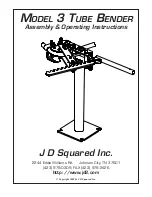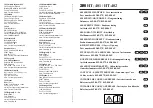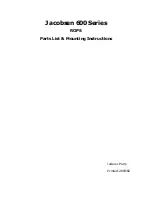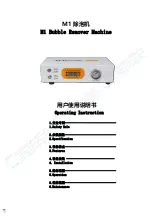
3
www.phywe.com, © All rights reserved
11260-
02 / -88 / 2516
8
Reset
Switches the vibration generator and the LED off. All
other settings stay at their current value to allow a quick
restart of the ripple tank.
9
Cal int.
For calibration of the integrated vibration generator. The
amplitude of the exciter can be set in a range from
80 %
to
120 % – independent of the external vibration genera-
tor. If the amplitudes should vary, this enables a syn-
chronisation of the amplitudes of the integrated and the
external vibration generator.
First press the
Cal int.
key. Immediately after that use
the (+) and (−) keys of the
Amplitude
selector (
) for fine-
tuning. The calibration is kept even after a reset (
) or af-
ter unplugging the power supply (
10 Cal ext.
Same as (
) for calibration of the external vibration gen-
erator. The amplitude of the external exciter can be set
independently of that of the internal exciter in a range
from 80 % to 120 %.
First press the
Cal ext.
key. Immediately after that sue
the (+) and (−) keys of the
Amplitude
selector (
) for fine-
tuning.
3.2 Further functional elements
In addition to the control panel, the ripple tank has the follow-
ing further functional elements (see Fig. 4, 5 and 6):
Fig. 4: Socket for the power supply (
) and sockets for the connec-
tion of the external vibration generator (
11 Connecting socket
12 V
For connection of the ripple tank apparatus to an exter-
nal power supply (supplied by default). The socket is on
the side of the housing.
12 Connecting sockets, external vibration generator
An external vibration generator with 4
mm plugs can be
connected here. The polarity of the connection is of im-
portance. To check polarity, the function
Pulse
) can
be used. If both the internal and external vibration gen-
erators move down when the button
Pulse
is pressed,
both will move in phase. Otherwise the polarity of the ex-
ternal vibration generator can be changed or the two vi-
brators work with a phase difference of 180°.
13 Wave tray
Waves are generated in the water filled in the wave tray.
Plastic foam has been stuck to the inner sides of the
wave tray. This allows an almost complete absorption of
the water waves that hit the sides of the wave tray and
thereby avoids unwanted wave reflections.
Fig. 5: Integrated vibration generator (
), hold-
ing rod (
14 Adjusting screws, 4 pieces
For horizontal alignment of the wave tray.
15 Integrated vibration generator
Serves to hold each type of exciter. By loosening the two
adjusting screws in the base, the exciter can be rotated
in plane.
16 Holding rod
Serves to mount and position the respective wave gen-
erator.
17 Wave generator
Serves to generate waves by dipping into the water while
the integrated vibration generator is switched on.
18 Tensioning screw
For raising and lowering the wave generator to a suitable
position in the water of the wave tray.
19 External vibration generator (accessory: 11260-10)
Can be used as second generator and is necessary for
the “Doppler effect” experiment.
Fig. 6: External vibration generator (11260-10) with accessories,
separately available.
4 HANDLING
This section describes how to put the water wave apparatus
into operation and cause water waves to be generated.
Please read this section carefully to avoid failure or improper
operation.
Note: To protect the apparatus from damage, the vibration
generator turns off automatically after 10 minutes of
continuous operation. Experiments are not expected to
take longer time in this operation mode.
19
11
12
17
15
16
14
13
18























